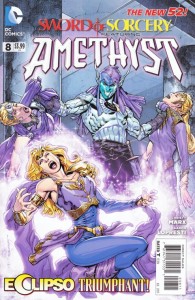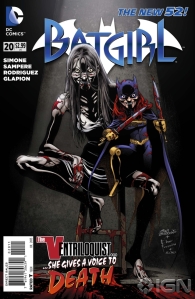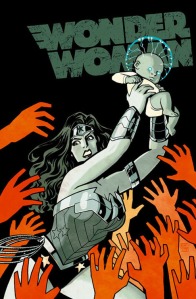This was a light week for my pull list, only four books – all DC titles, all ladies, and, for better or worse, all family dramas. To be fair, family dramas seem to be in right now, and not just with the women. Animal Man, Green Arrow, Aquaman, and Phantom Stranger, not to mention most of The Batman family books, all feature family oriented narratives these days. I’m quite alright with that, all of the books mentioned are among my favorites and there really isn’t anything like the complex nuances of familial bonds when it comes to heightening the emotional resonance of a storyline. Of course, like anything else, treatment matters a lot in terms of how potent, original, and meaningful the emotional fireworks manage to be. So how did Sword of Sorcery, Batgirl, Batwoman, and Wonder Woman make out this month? Read on to find out!
Writer: Christy Marx
Artist: Aaron Lopresti
DC Comics
Sword of Sorcery #8 claims the unfortunate dual distinction of being the only book on this list that was not part of the original launch of the New 52, and the only of these four books on its final issue. This book had quite a bit of potential from the get-go and ended up suffering, though not so much from the shortcomings of its creators as from its premature death. I’m not quite sure why this comic had to end before being really given a chance to find its audience but I do lament the fact that this cancellation, along with that of books like I, Vampire, Frankenstein, and the recently announced discontinuations of Demon Knights and Dial H, represents a movement away from a level of genre diversity and risk taking that got me excited about the New 52 almost two years ago.
This issue sees the conclusion of the showdown between house Amethyst of Gem World and the evil Eclipso. The story does manage to tie up all of the narrative strands that Marx put in place, but it does so without the level of complexity that I think the series could have exhibited. The power struggle between Lady Amaya’s mother and aunt over the bloodline of house Amethyst is resolved, as is the similar, but gender-opposite, one in house Diamond. I’m happy to have the closure, yet I can’t help but feel a little bit let down by the relative ease with which these transfers of power were facilitated, given the momentous ramifications they were meant to signify within this world. A prolonged series of twists, turns, betrayals, and role reversals would have been so much more satisfying.
But what’s done is done I suppose. On the positive side, Lady Amaya emerged as one kick-ass young hero whose transition from a reluctant teenager into a confident and powerful woman, at least, felt paced realistically enough to carry the emotional weight that it deserved to. Thanks for this are due in no small part to the emotive pencils of Aaron Lopresti, who captures Amaya’s strength in a handful of breathtaking splash pages. Together the team of Marx and Lopresti managed to characterize a slew of relatable and inspiring women while avoiding the clichés that unfortunately still characterize many a heroic woman in comics. As an added bonus, they did so in an idiosyncratic and gloriously Labyrinth-esque style that at least this reviewer will miss.
Batgirl #20
Writer: Gail Simone
Artists: Daniel Sampere and Carlos Rodriguez
DC Comics
Gail Simone really started to hit her stride on this title with the Death of the Family tie in issues and, thankfully, she’s still running at that pace. This iteration of Batgirl hasn’t always been a family-focused drama, in fact, it was very much a book about Barbara proving to herself that she could make it on her own after recovering from the devastating spinal cord injury that, although somewhat revised, occurred during the Alan Moore penned Killing Joke story. That all blew up in her face when the Joker kidnapped her mother, and her psychopathic brother, James Jr., tried to kill her roommate.
Currently reacting to the fallout of those events, specifically the death of James Jr. at her hands, Babs is undergoing a pretty major crisis. She’s no longer sure she is even fit to wear her uniform. Meanwhile, a sinister new version of The Ventriloquist is unleashing havoc on Gotham and has Batgirl in her sights. The Ventriloquist is a fun character, thanks to a simple but compelling origin story as an insecure misfit with a sociopathic streak turned reality show reject, and a drill bit wielding dummy rife with exploitation style excess.
But The Ventriloquist isn’t the only one after Batgirl, Commissioner Gordon (that’s right, her dad, though he has no idea) is out for blood to avenge the murder of his son. Yes, its simple. No, its not really original – but it works dammit, and I look forward to watching it play out.
Writers: J.H. Williams III and W. Haden Blackman
Artist: Trevor McCarthy
DC Comics
And then there’s Batwoman… As far as strong female comic book characters go, she is bar-none at the top of the heap. But saying that doesn’t do her justice; she holds her own against any character in comics, regardless of gender. Furthermore, its not just her tenacity and strength (which she does have in spades) that puts her at the top, but the complexity with which Williams and Blackman write her that really puts her over the edge.
Take Batgirl as a point of comparison. She is a great character, but relatively one dimensional, as most heroes tend to be. She is defined by a compelling mix of insecurity, resourcefulness, and bravery. While the contradictions in her nature make her interesting, they don’t necessarily make her complex. In contrast, when Batwoman interacts with in her various relationships, she displays attitudes and actions all across the emotional spectrum, lending her a nuanced realism that not only provides emotional impact, but keeps her story fresh and her readers surprised.
She is relentlessly bullish and stubborn, presenting her father with a cold and unforgiving face while her love for her Fiancé, Maggie Sawyer, is seemingly endless. Her tenderness and compassion for her recently returned sister contrast with her vicious sadism when donning cape and cowl. We are never sure which side of Kate Kane will emerge in any given situation, but each is beautiful because it is a part of her fascinatingly complex character.
Her relationship with Maggie gets its fair share of attention in the media because they are a lesbian couple, but, to echo my earlier statement, it is without a doubt the best drawn relationship in any mainstream comic book. Maggie is so much more than a plot device waiting to happen, in a way, she is able to draw together the diverse and nuanced aspects of Kate Kane, she loves her when she has no one else to turn to, and she puts her in her place when no one else can (as she does in this issue).
in the narrative strand that this issue kicks off, Batwoman is blackmailed by the D.E.O into unmasking Batman. Any other character and this story would be over before it started – no one in Gotham could stand up to Batman, but I’m guessing Kate will give him a run for his money. I’m also willing to bet that with Williams and Blackman at the helm, it won’t turn out the way we’re expecting.
Wonder Woman #20
Writer: Brian Azzarello
Artists: Goran Sudzuka and Cliff Chiang
DC Comics
From an artistic standpoint, Cliff Chiang, Tony Akins, and now Goran Sudzuka, have done a breathtaking job with Wonder Woman. She has poise, strength, and beauty. This incarnation of the character is allowed to exist as an A-lister without ever being forced into typically masculine archetypes or having her femininity objectified.
Wonder Woman’s strength, in particular, is on display in this issue, which largely consists of her battle with Artemis. It’s an epic, airborne affair in which Diana proves that even the gods have another thing coming if they try to mess with her friends, and their children. But the family narrative doesn’t simply follow the mother/protector archetype that it appears to at first glance. Diana’s relationship with her clan is much more complex than that. Yes, she does play the role of mother at various points, but she is also the General, and, at times, the child.
Its the way these characters relate to one another that makes the story so compelling: the way in which Hera learns compassion, War learns humility, and Zola gains confidence. Somehow this odd group of gods and demigods manage to bring out the best in one another. Wonder Woman isn’t so much the leader who draws it out of them, but the catalyst that allows them to find one another. As Zola says to her unknowing little boy in this issue: “you have a weird family. A weird, wonderful family.”
Both major publishers have taken a lot of slack for the underrepresentation of women in their comics, recently Bleeding Cool called DC out for only featuring two pages of lady-led books in their DC essentials catalog, but I can’t deny that these four titles, especially the latter three, represent some of the best books being written across the medium. From time to time its worth talking about how good some of lady heroes are. Of course we need more, but its not for lack of a model. Read these books and hopefully it will start to catch on.







 Posted by tvgilbert
Posted by tvgilbert 




